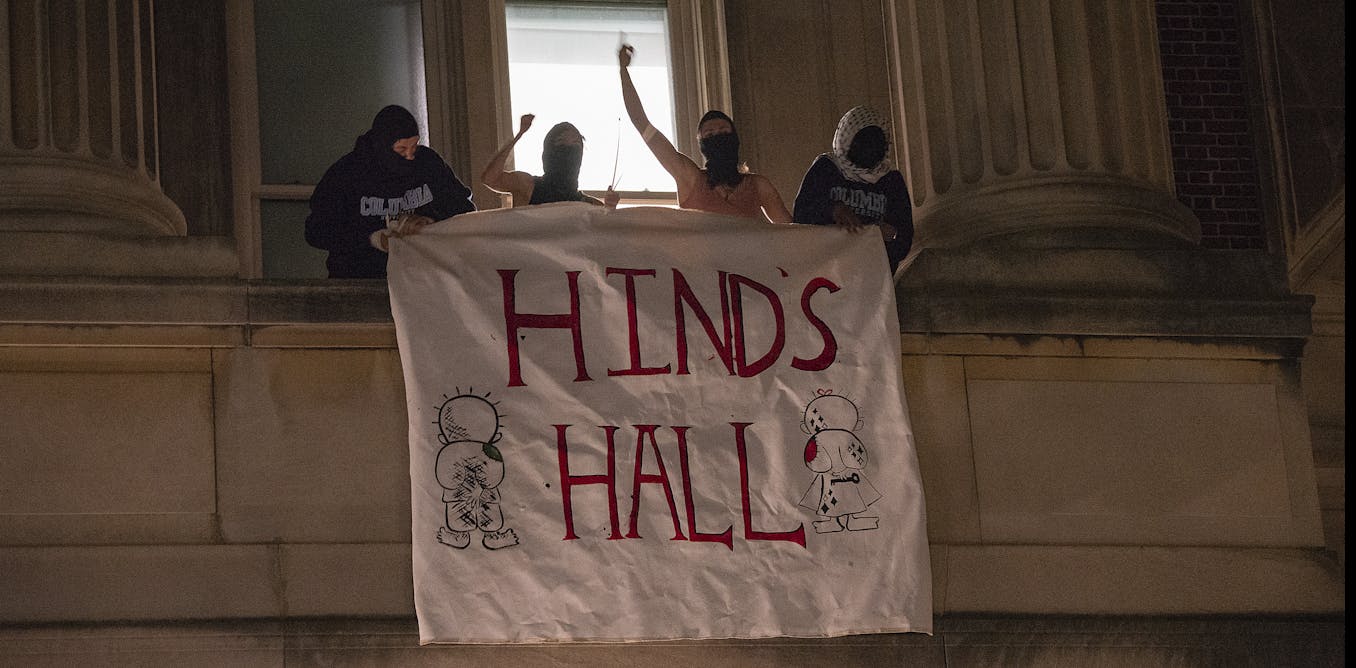Twenty-four hours after the release of Macklemore’s pro-Palestine protest song Hind’s Hall on social media on May 7, the video had already notched up over 24 million views.
In two minutes and 49 seconds, the music video uses found footage gleaned from social media feeds intercut with the songs lyrics in white text on a black background.
Much of the footage is of pro-Palestine encampments unfolding on the grounds of US universities. We also see images of popular Palestinian journalists Bisan Owed, Motaz Azaiza and Wael Al Dahdouh, footage from the Israeli bombing in Gaza, and older footage, such as N.W.A.’s Fuk Da Police (1988).
Much of the imagery is illustrative of the lyrics and polemic in messaging.
This use of found, gleaned and archival footage is a continuation of a long tradition in video art where artists have used existing footage to comment on and amplify social, political and environmental issues.
What is found footage?
Found footage filmmaking is a strategy used by artists and filmmakers who take audiovisual material from its original source and re-contextualise it.
Removed from its original context, this footage allows the artists to create new associations and critical perspectives on the material, culture and circulation of meaning. This process is also called remediation.
Prior to the proliferation of digital media, found footage artists found inspiration in newsreels, films and archives. Tracey Moffat worked with editor Gary Hillberg from 1999–2017 in creating a series of films call Montages, which reflect on tropes in Hollywood films.
Christian Marclay’s The Clock (2010) was a 24-hour video installation compiled from hundreds of films with scenes of clocks, watches and other timepieces.
Adam Curtis’ feature films draw on the vast BBC archives, which meditate on politics, power and psychology.
The advent – and plethora – of user-generated content on social media has given rise to new possibilities for video content.
With an endless flow of images and information through social media scrolls, the question of how to interrogate this material underpins how video artists approach found footage today.
Amplifying truths – and misinformation
The launch of YouTube in 2005 brought the ability to participate in the creation and sharing en masse of self-made video content.
Artist Natalie Bookchin saw this outpouring and sharing of personal testimonies through vlogs as an opportunity to reflect on the the contemporary social, cultural and political landscape in the United States.
Editing these vlogs, Bookchin created choral-like multiscreen video installations. Bookchin’s 2009 work Testament, a three-chapter multi-screen video installation, meditates on the shared vulnerability, isolation and collective experience of prescription medication, job loss and sexual identity.
Surrounded by the multiple voices in the gallery, the individual voices become a collective outpouring, giving voice to feelings of doubt, shame, anger and resignation. The multitude of voices transform an individual experience into one that reflects the impact of social and political pressures.
Bookchin’s follow-up work, Now he’s out in public and everyone can see (2012), similarly uses YouTube vlogs – but this time focused on the perception of African American men as threats.
Originally an 18-screen installation, the video excerpts speculate and comment on incidents involving famous African American men. This creates a collective narrative where there is always contradiction and never a singular agreed-upon truth.
In doing so, this work comments on how social media circulates and reinforces rumours, stereotypes and misinformation.
Montage and juxtaposition
Political commentary can also be made through juxtaposing unexpected images and sound. Montage editing is a technique first used by Soviet-era filmmakers in the 1920s through which the “collision” of images creates a new meaning.
American artist and filmmaker Arthur Jafa uses this technique to great effect in Love is the Message and the Message is Death (2016).
In this eight-minute video, Jafa takes up the question of the representation of African Americans through the 20th century through montages of found footage from film, music video, sports broadcasts and vlogs to the soundtrack of Kanye West’s Ultralight Beam.
The video oscillates between the hopes, dreams and great creative and sporting successes of Black Americans, undercut by the pervasive threat of systemic violence and white supremacy.
Long sequences of music, dance and sporting prowess, backed by West’s melodic anthem, are suddenly replaced by sounds and images captured on a mobile phone.
This footage feels familiar whether we have seen it or not. A scene taken from inside a car of a Black woman being pulled over by the police crying out for her children sits between that of gospel singing and the civil rights movement, demanding us to question what progress has been made.
While Macklemore’s found footage practice might seem unsubtle, given his platform, that’s also the point. Accompanied by unambiguous lyrics, re-presenting these images to a broad audience aims for maximum impact in a screen environment where attention is in constant demand.
Found footage gives video artists strategies to challenge dominant ways of thinking and reflecting on socio-political issues. When we see footage we know from social media, the news or films, we are given the opportunity to bring disparate ideas together, and challenged to see the world anew.






